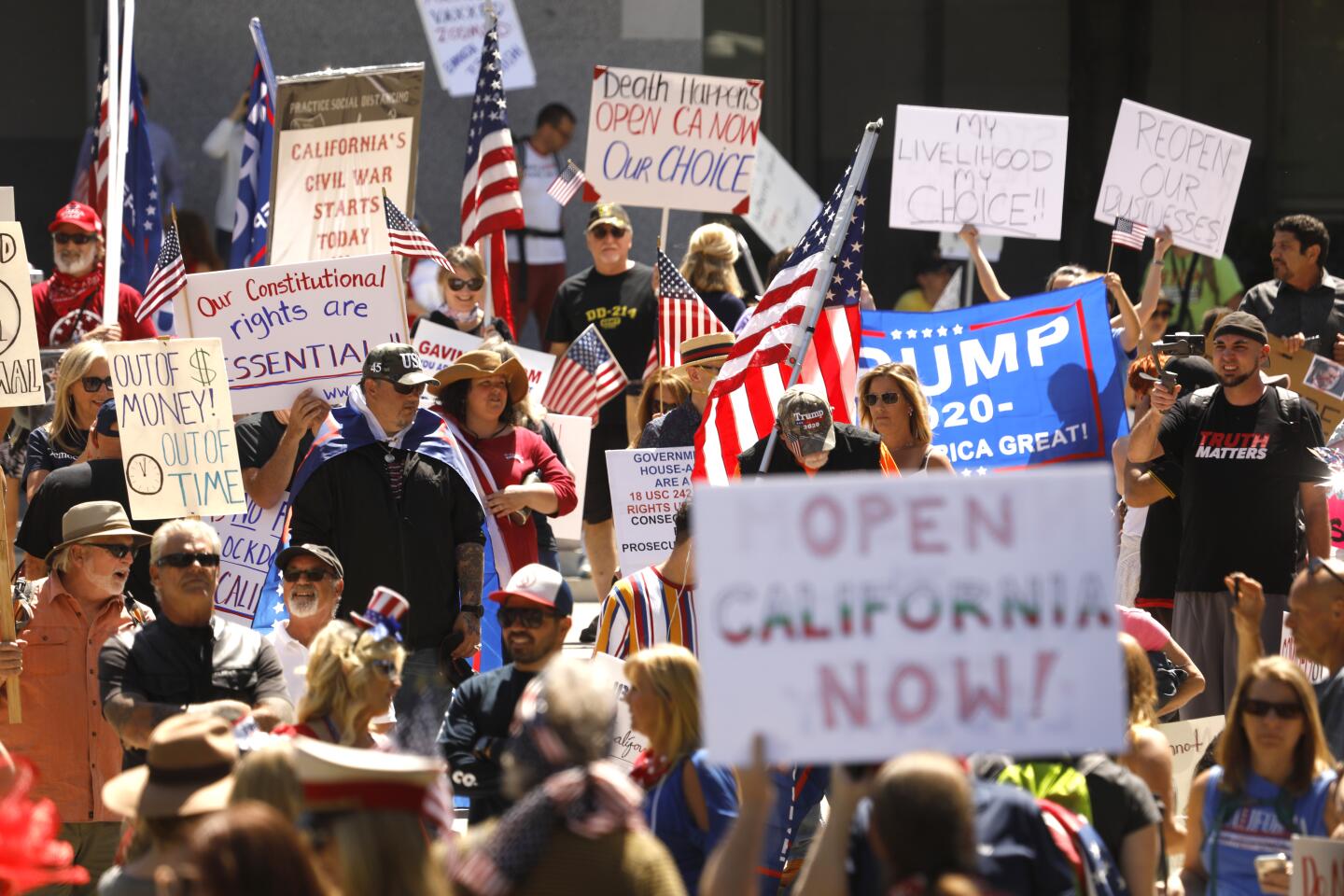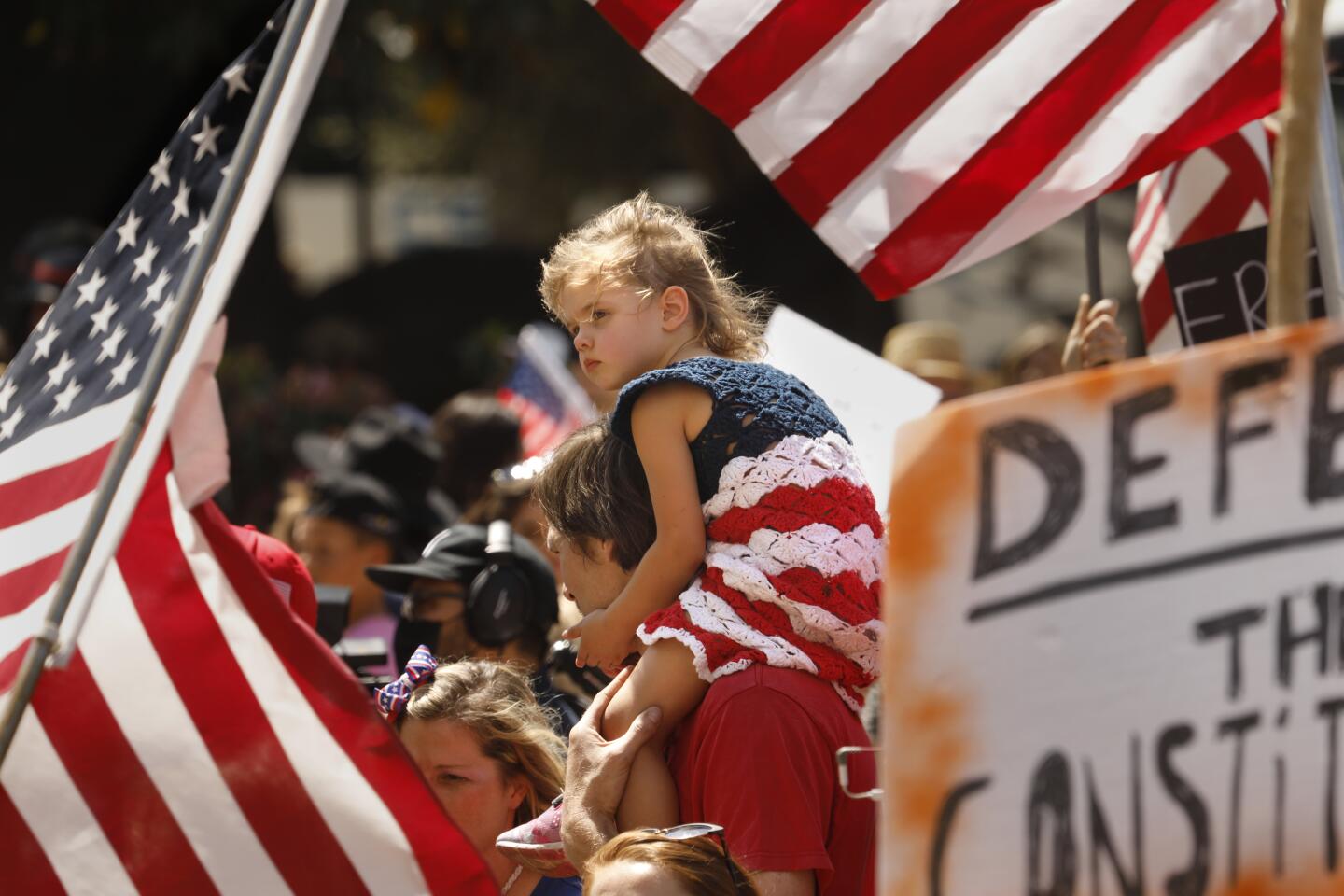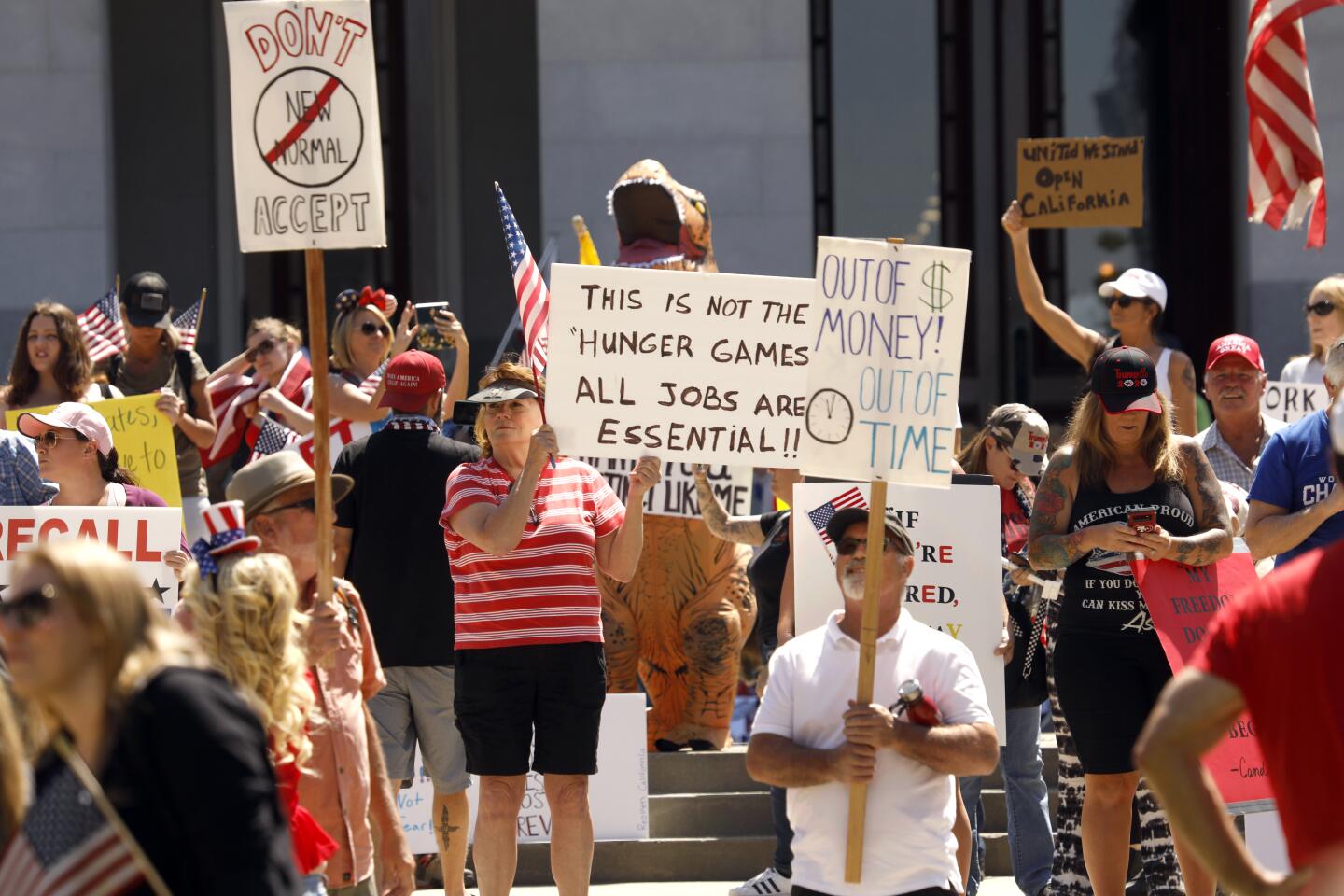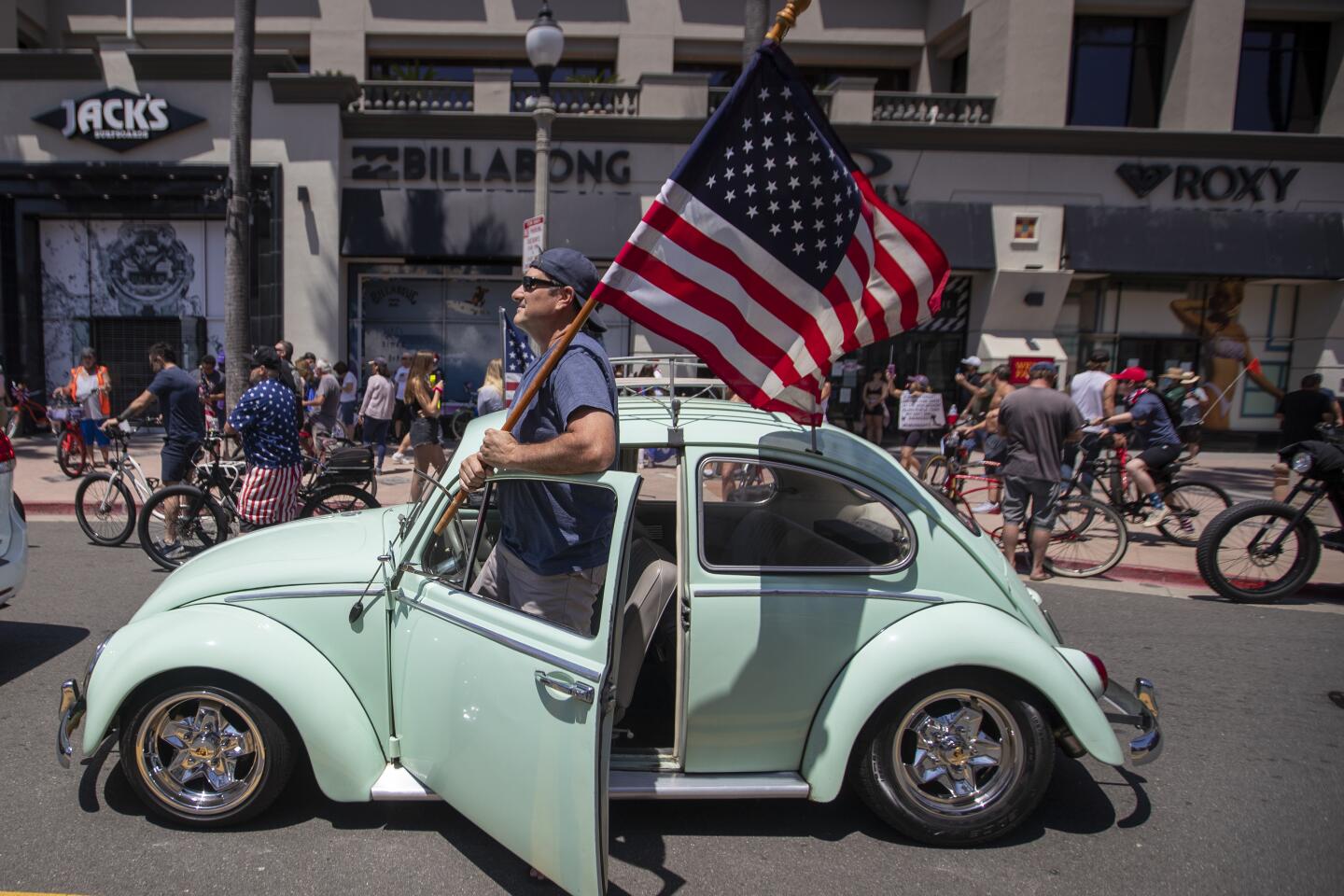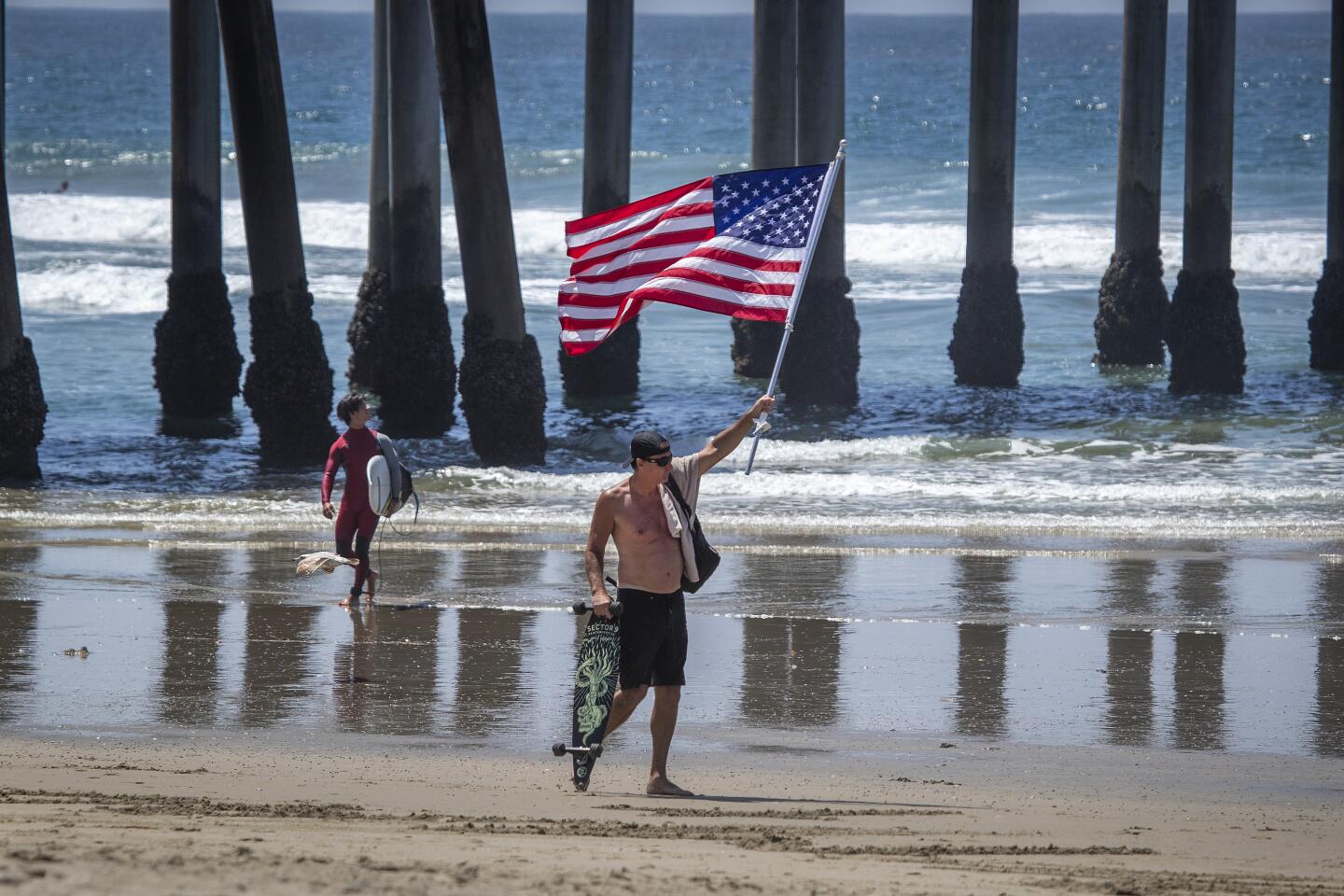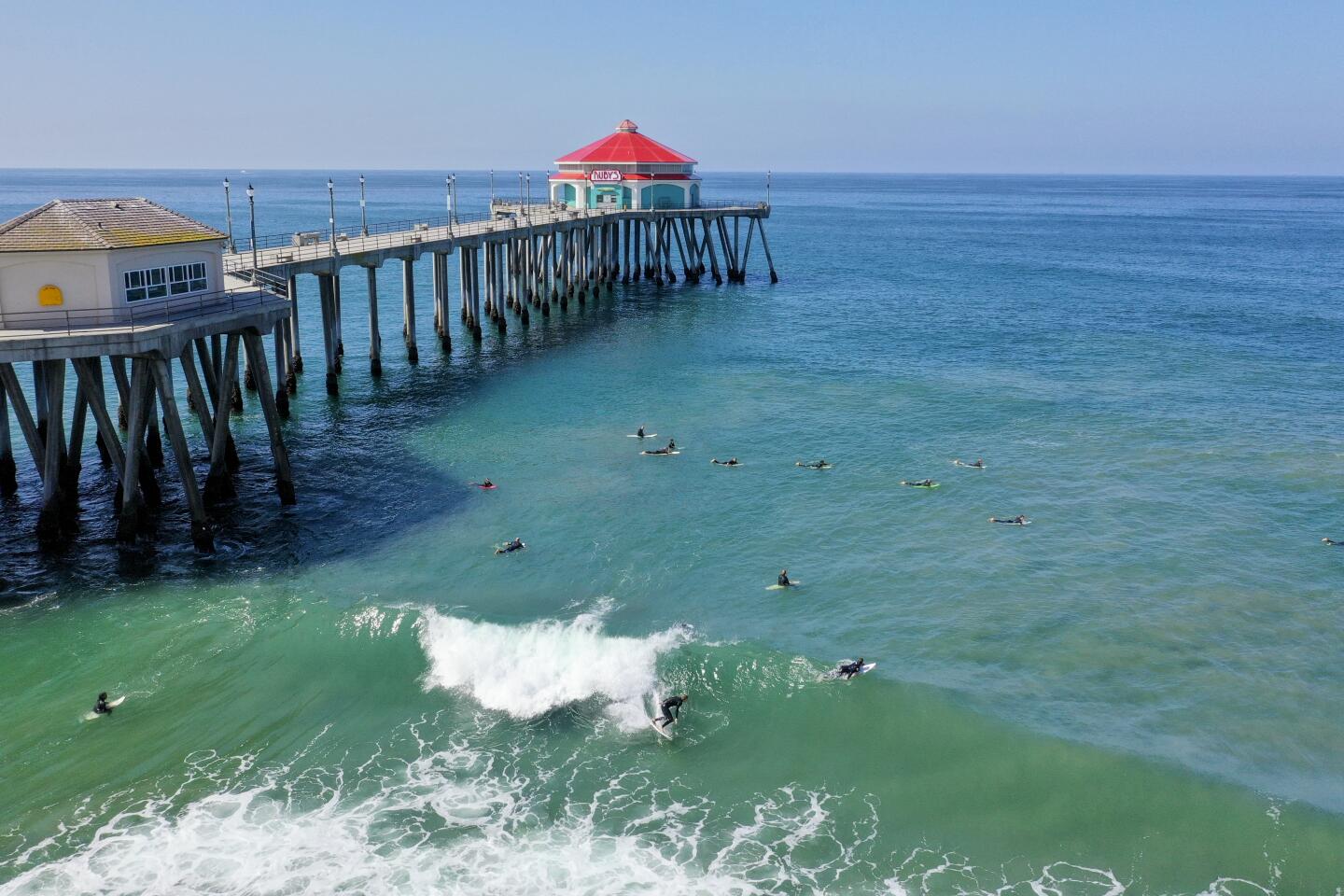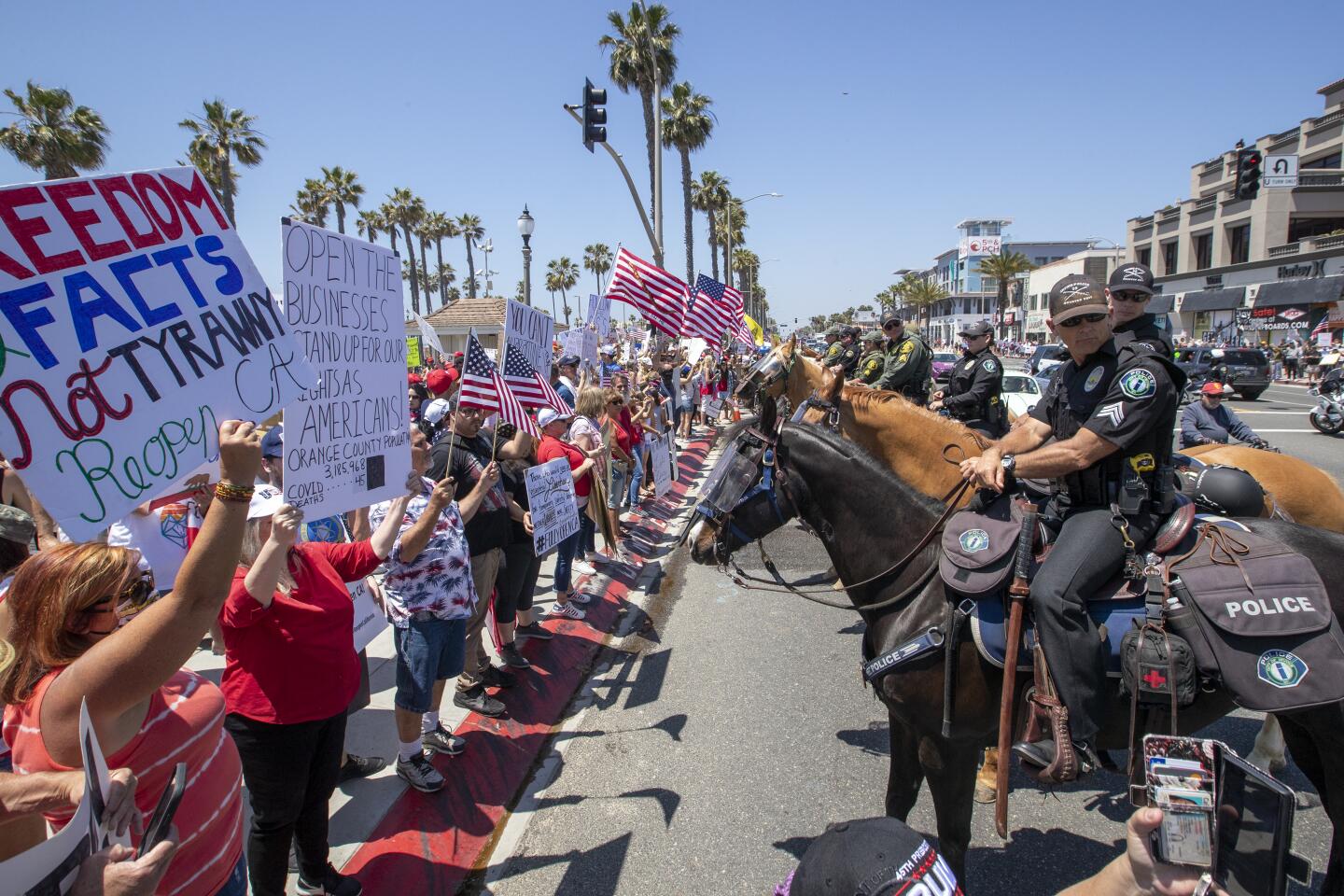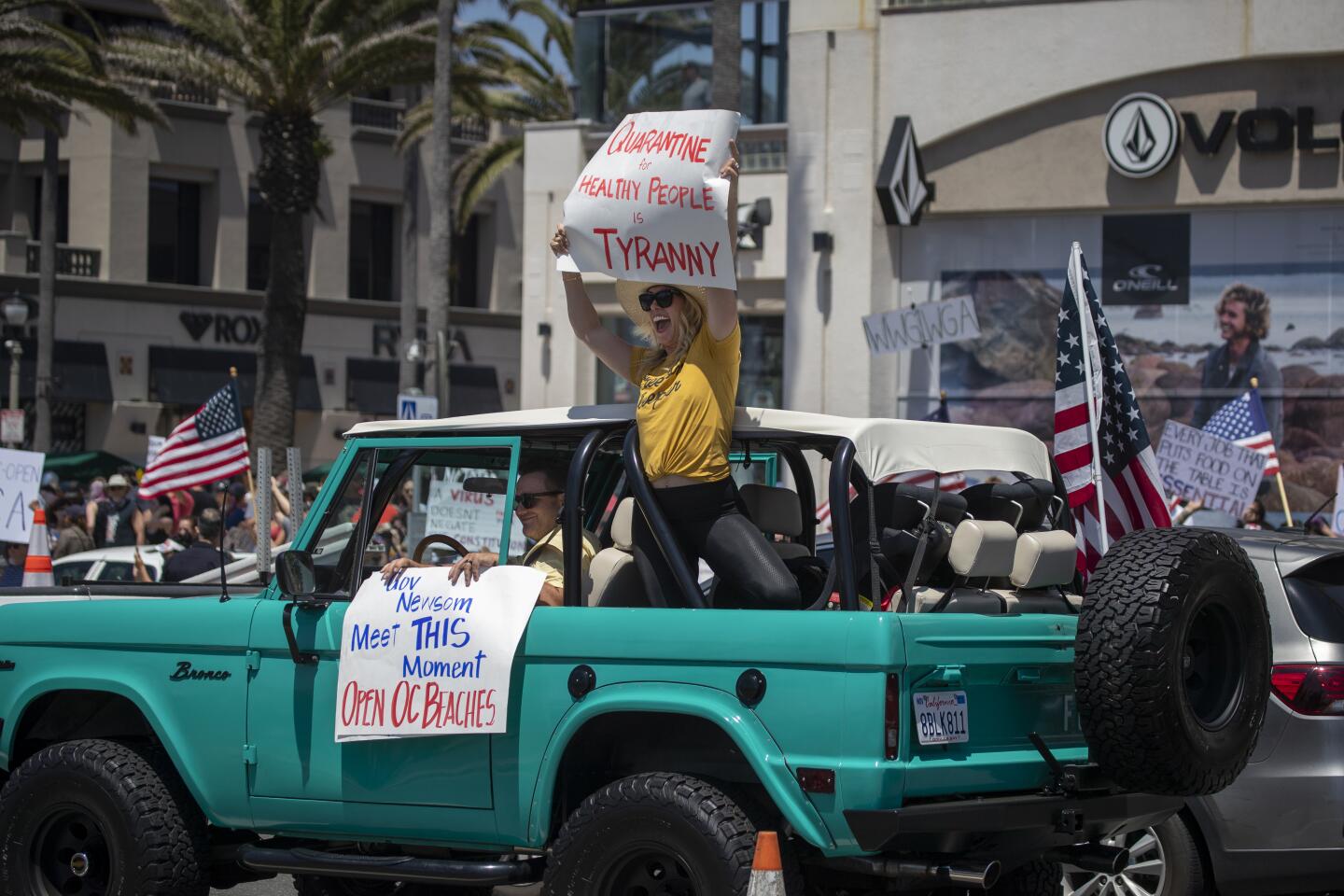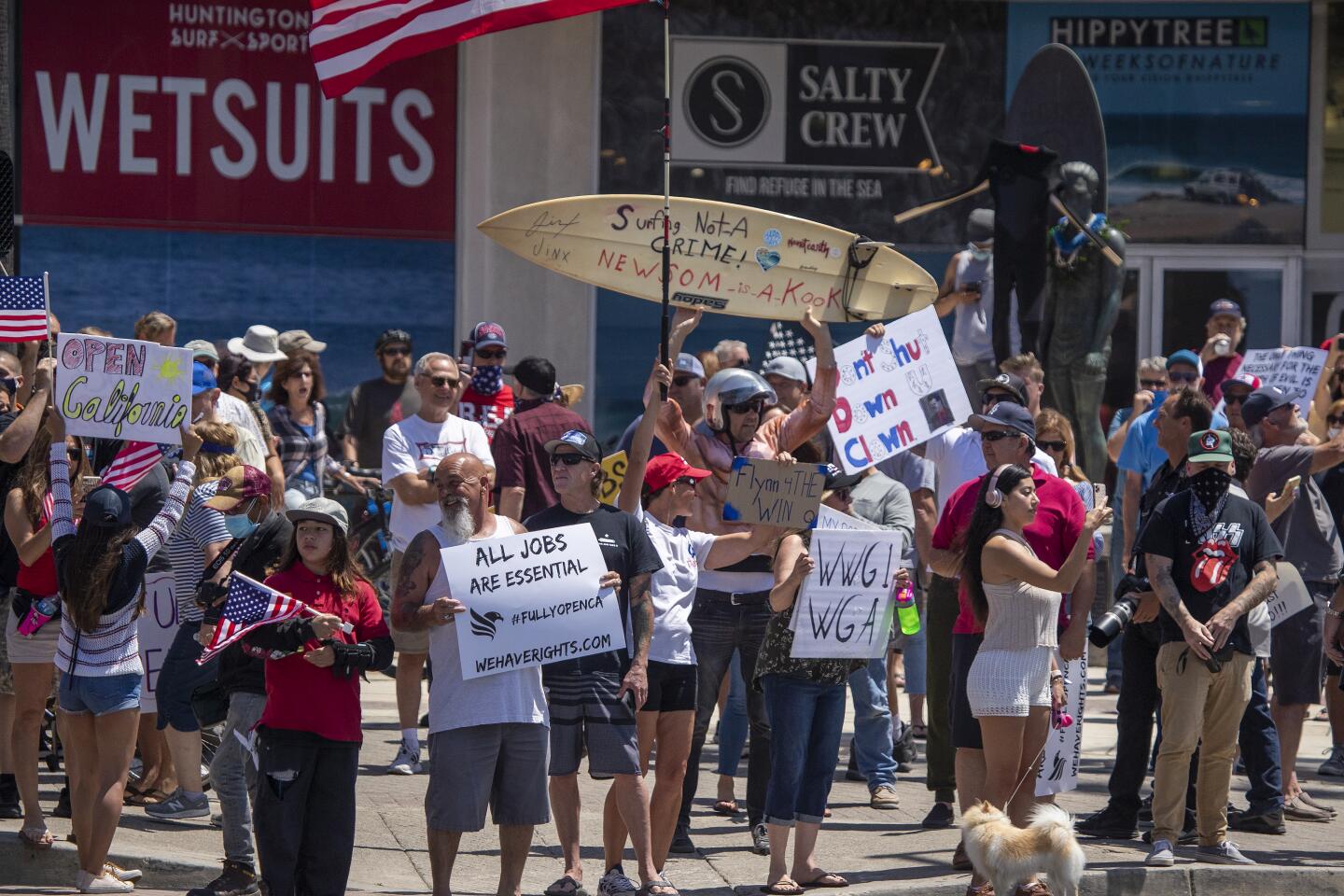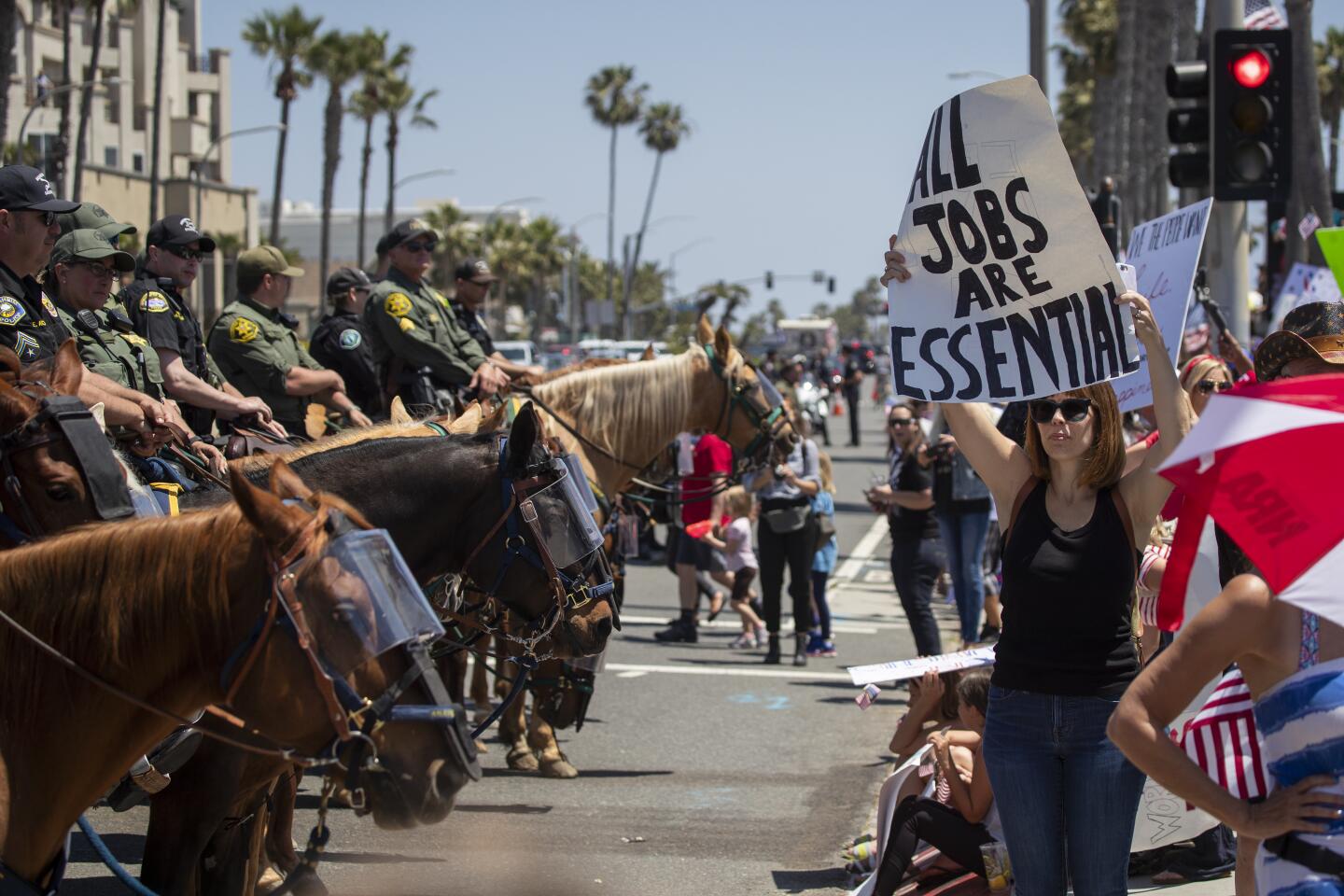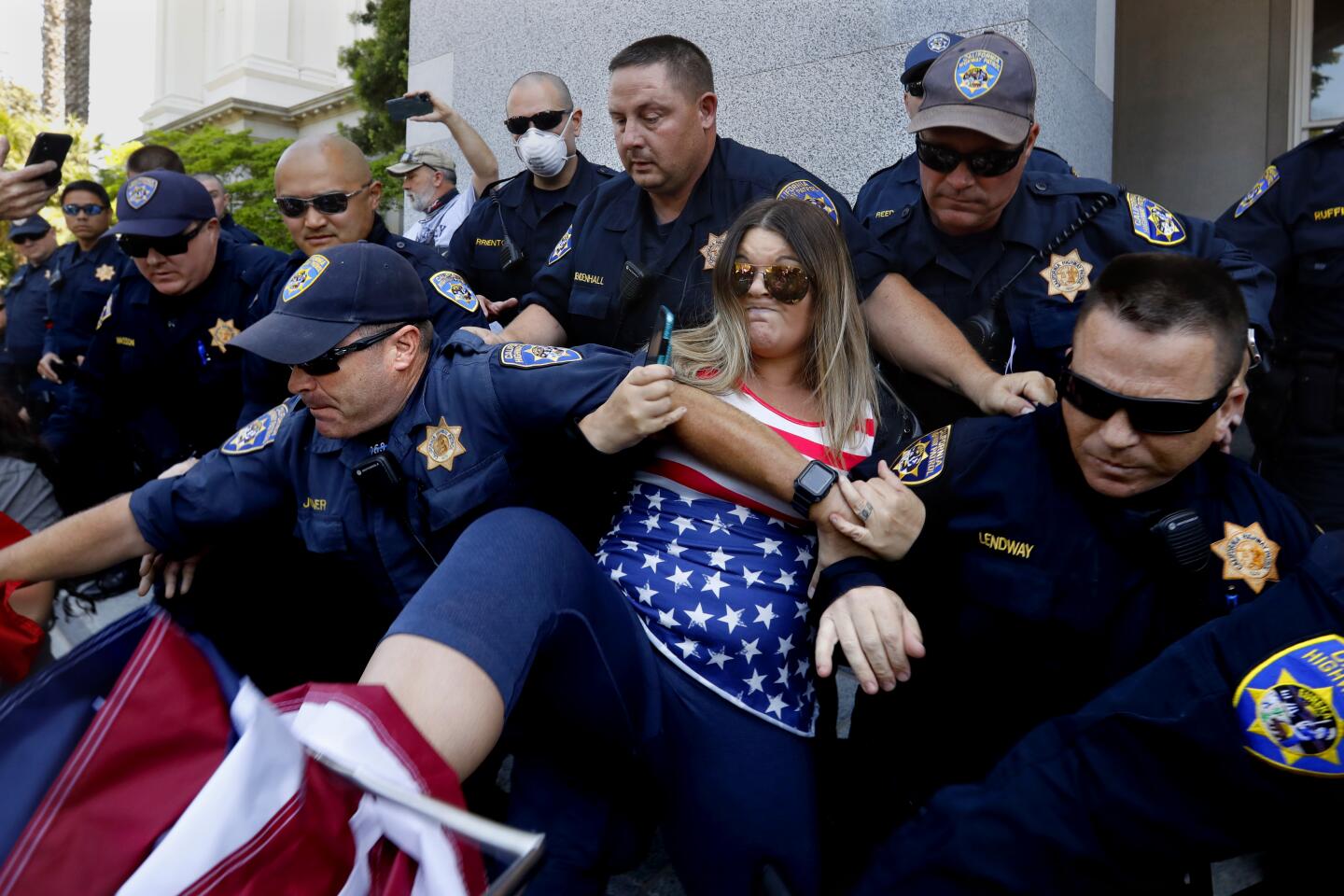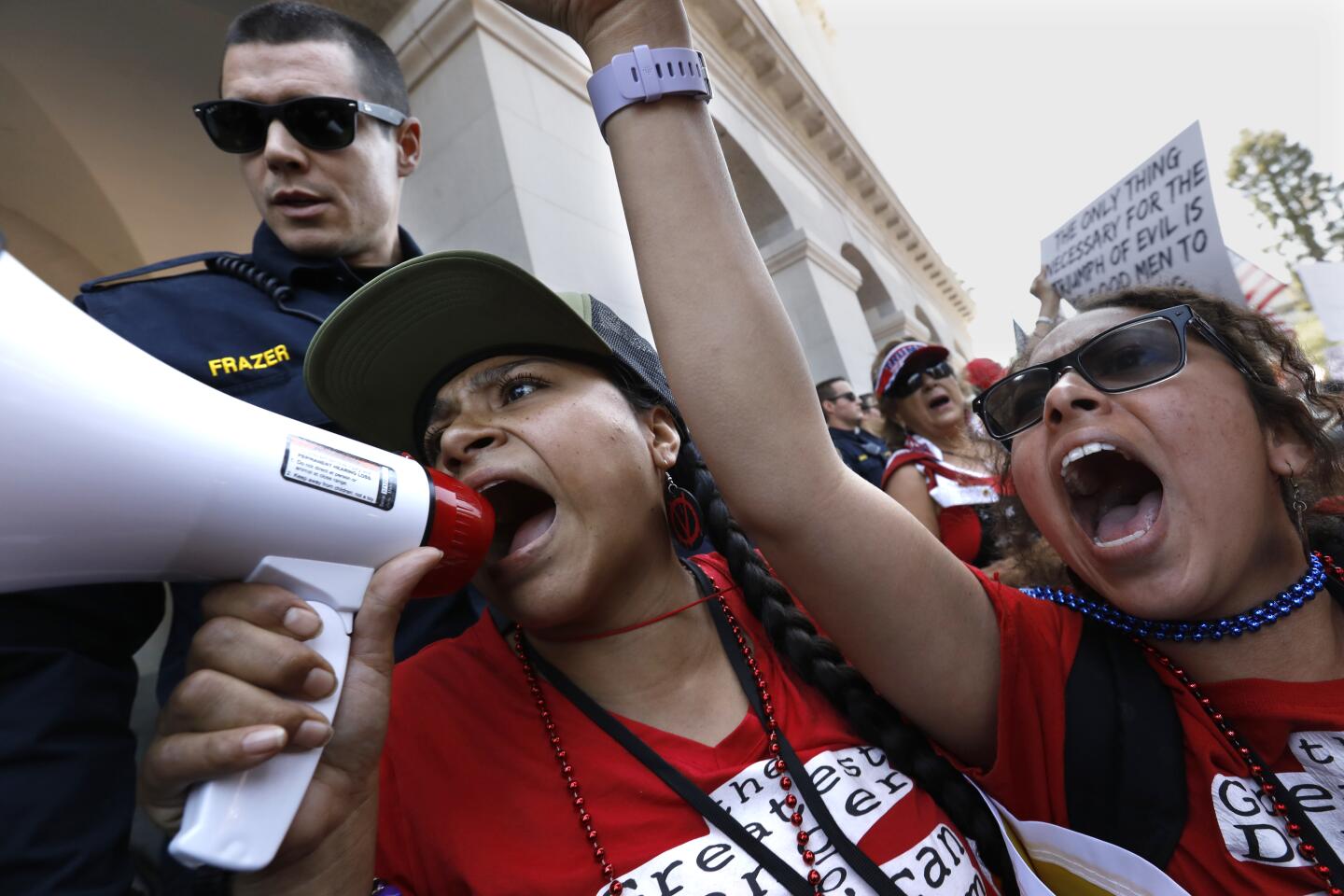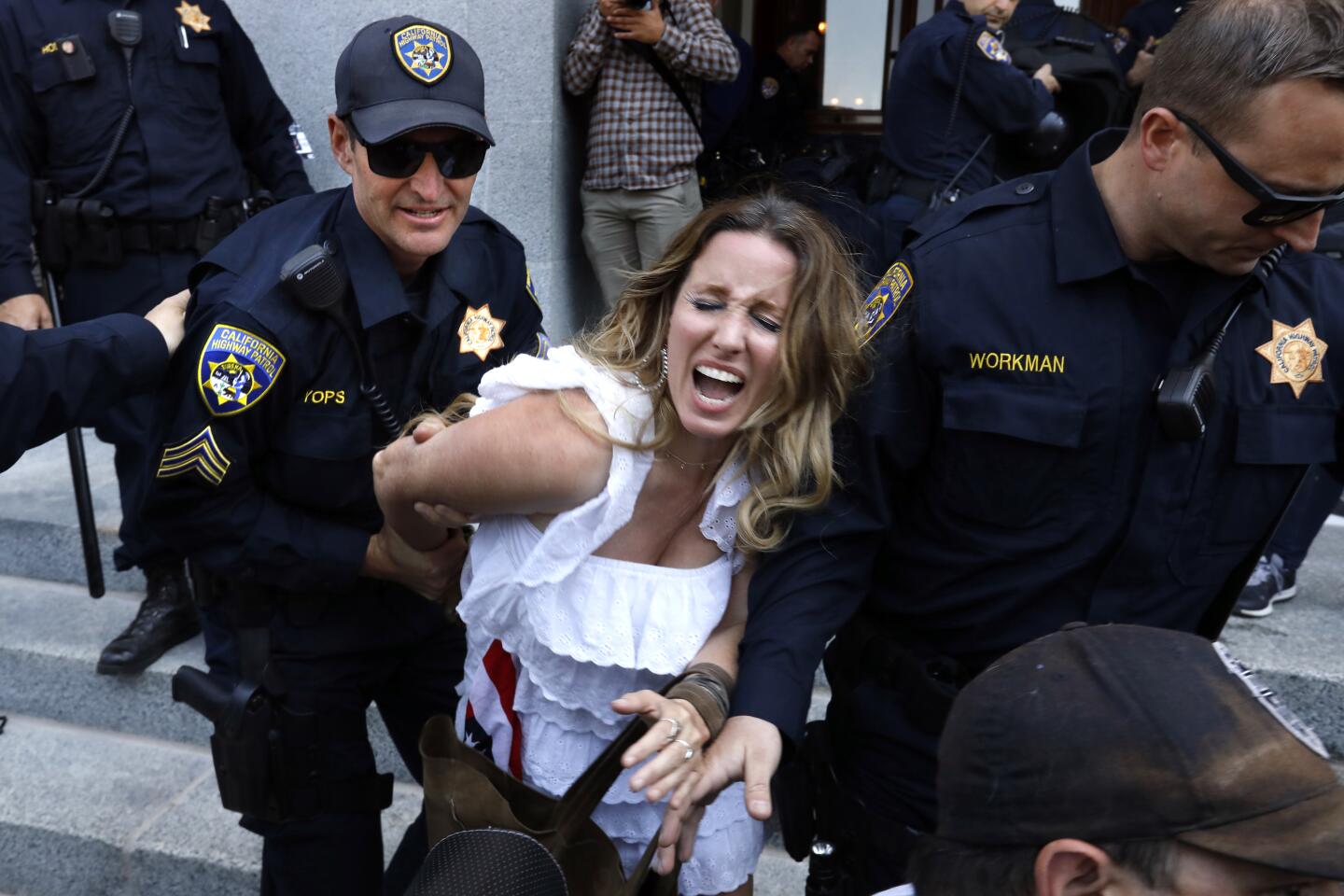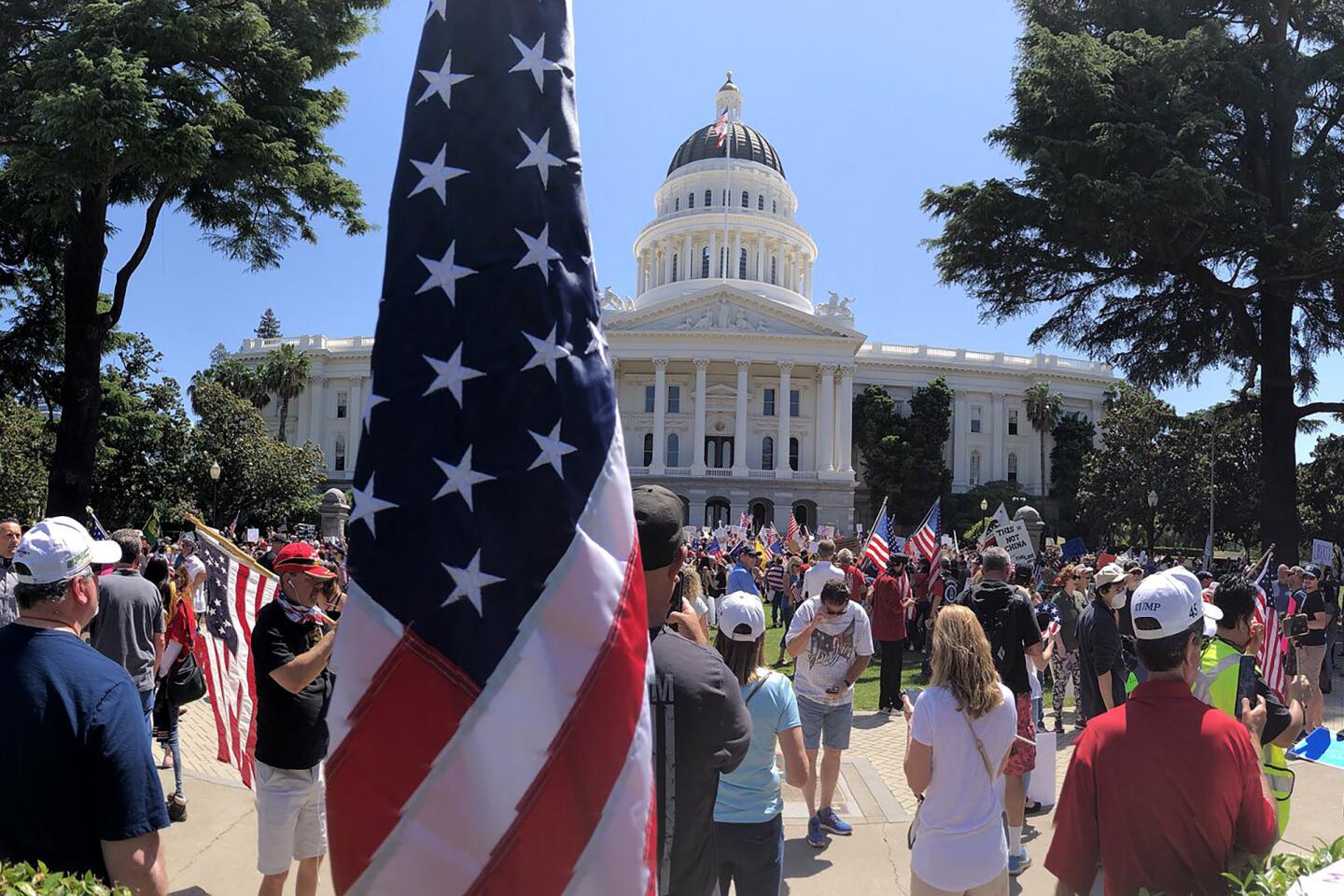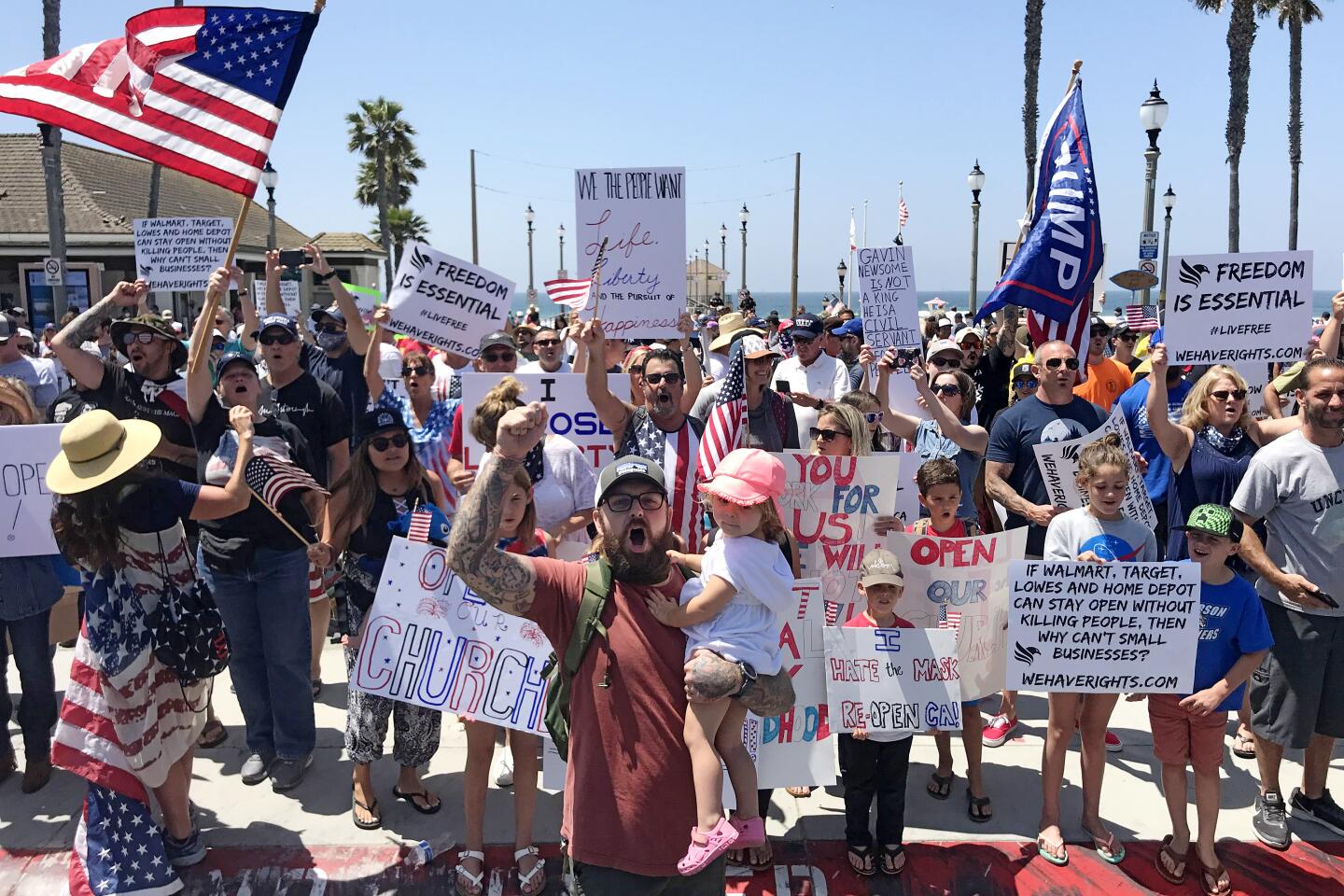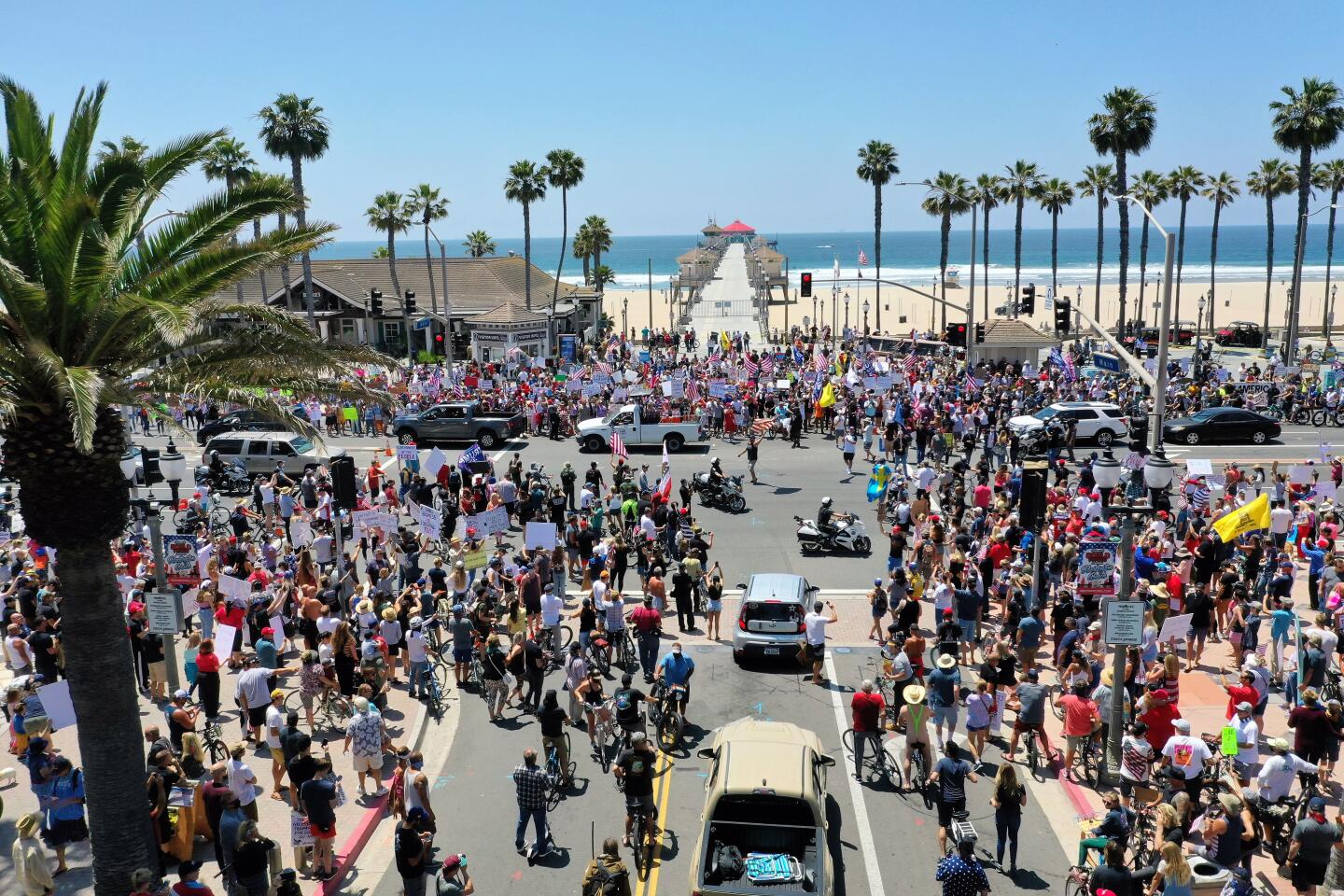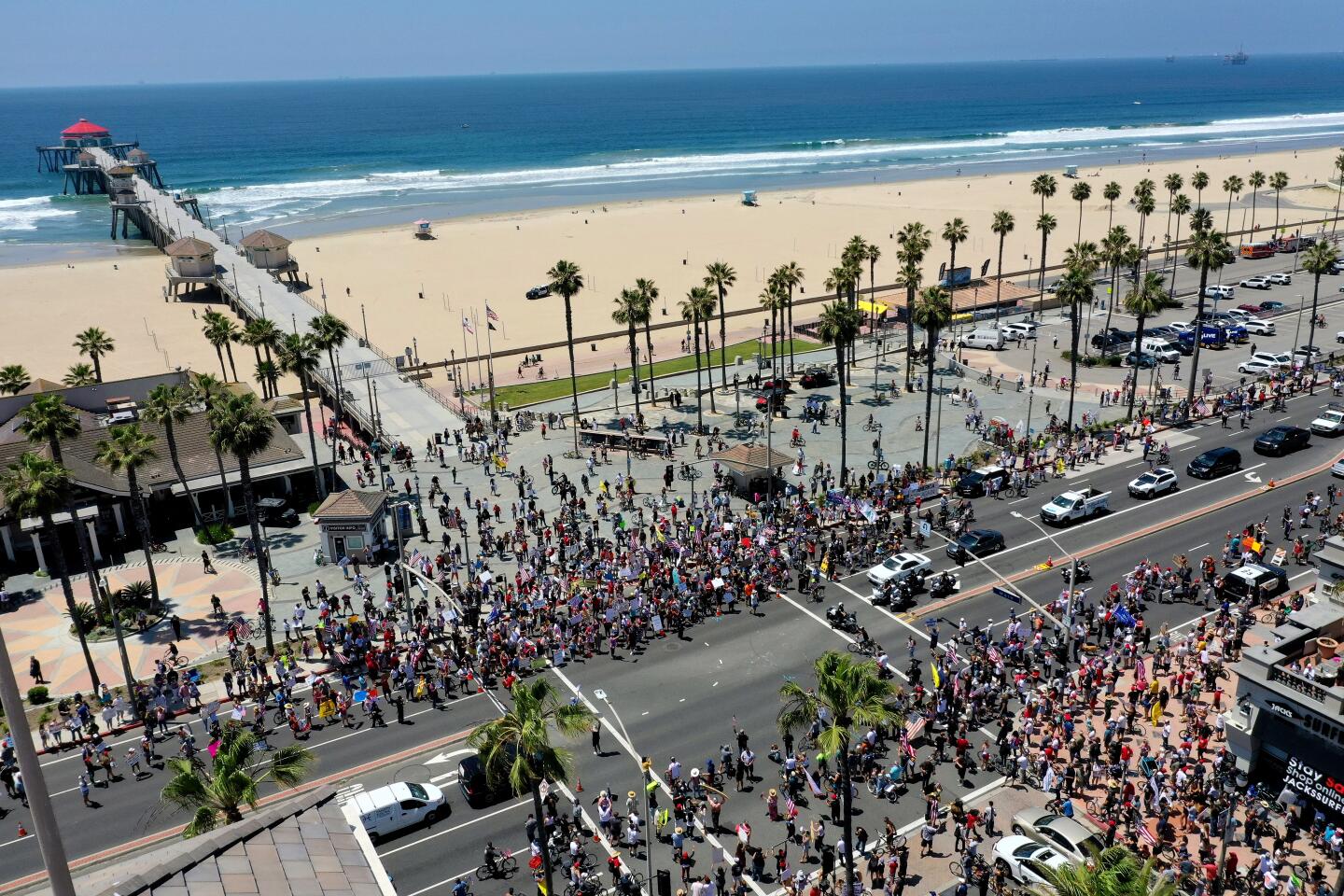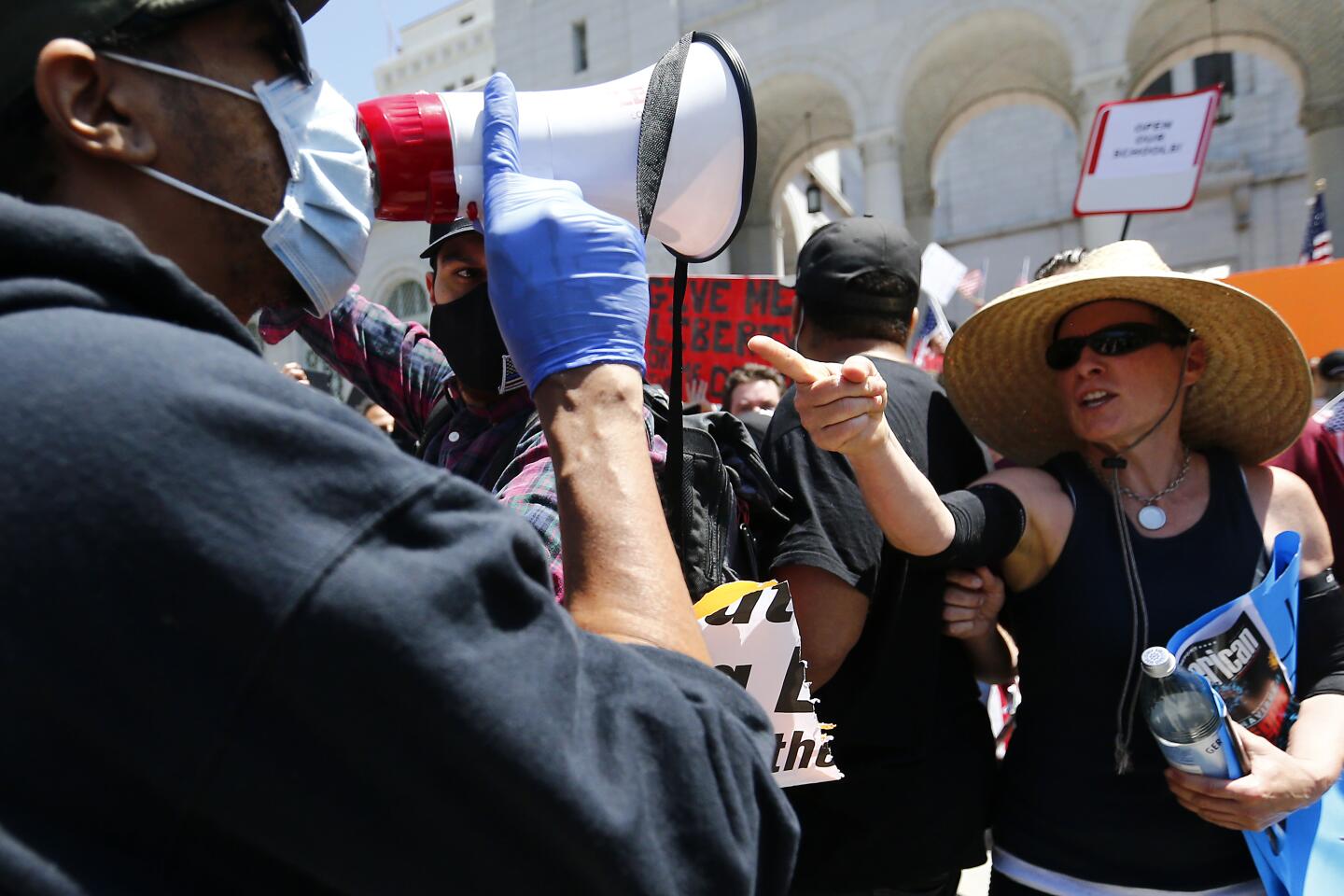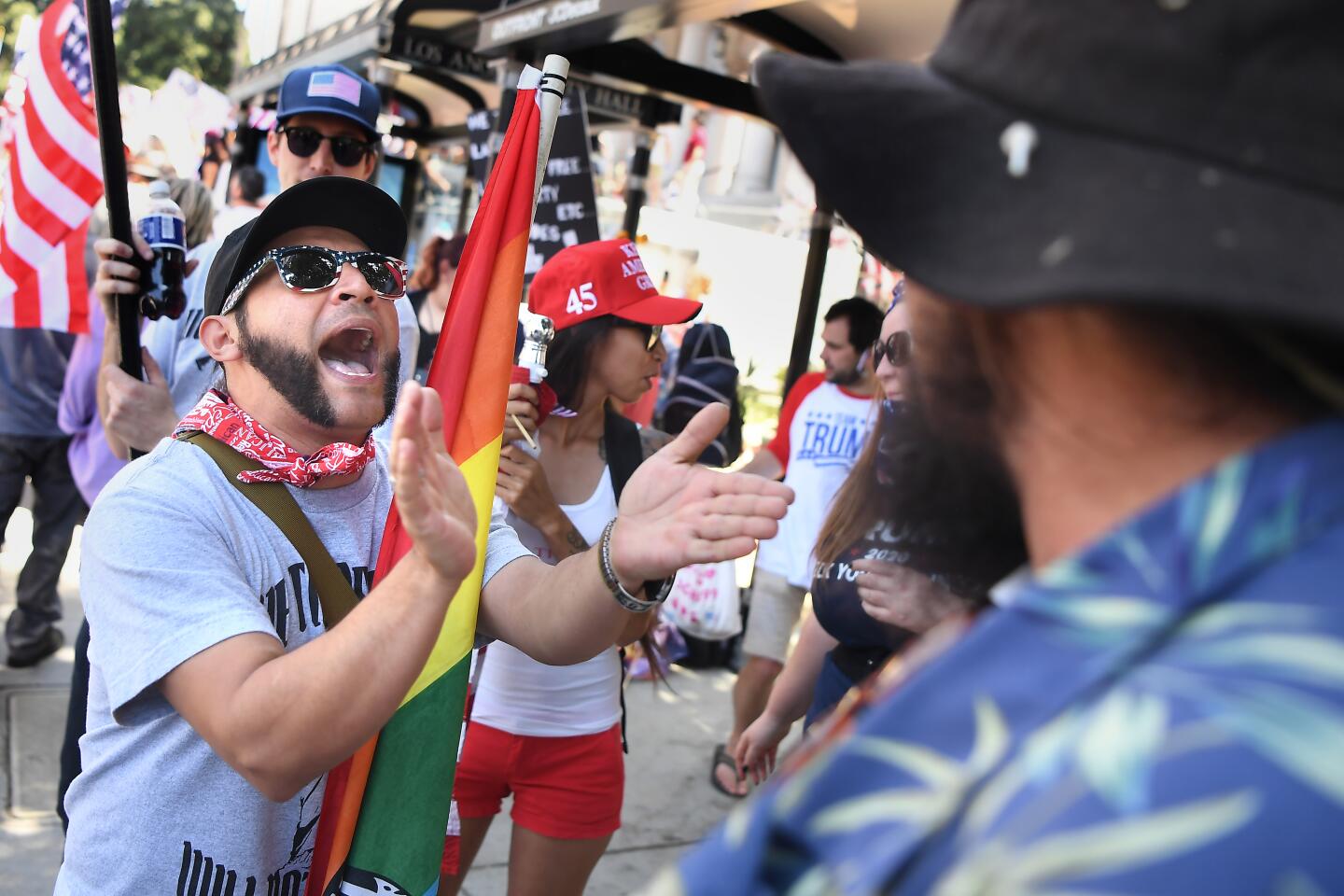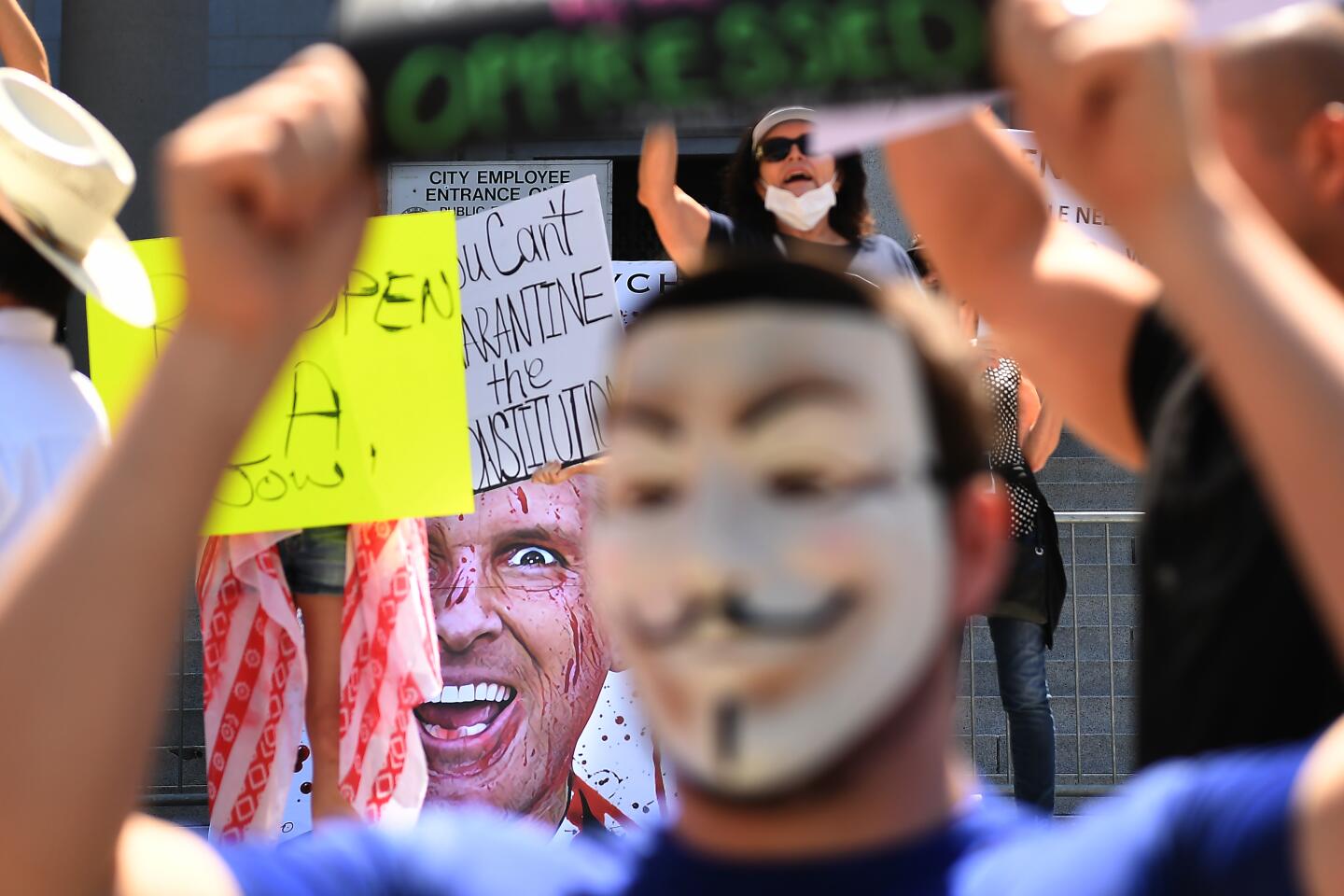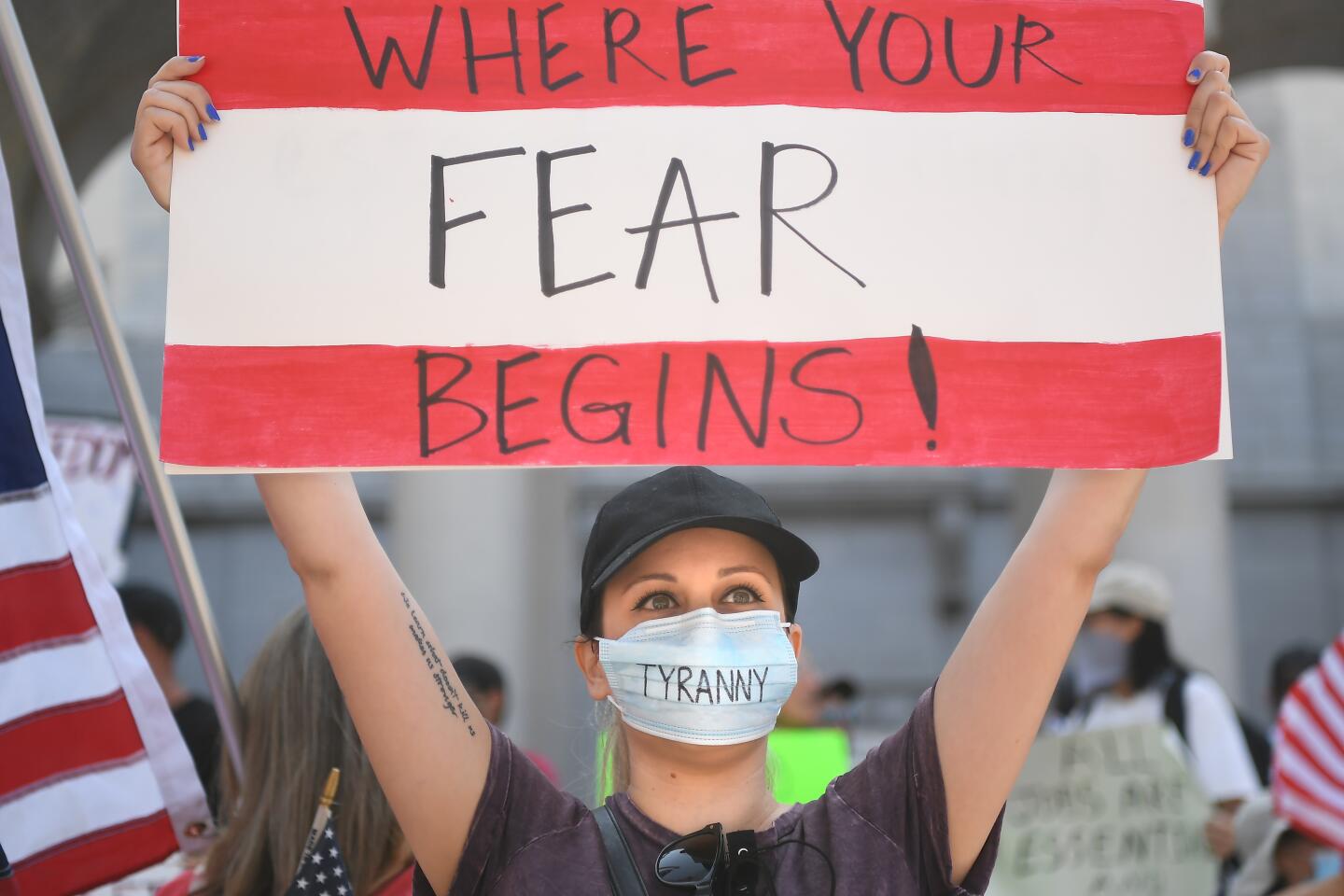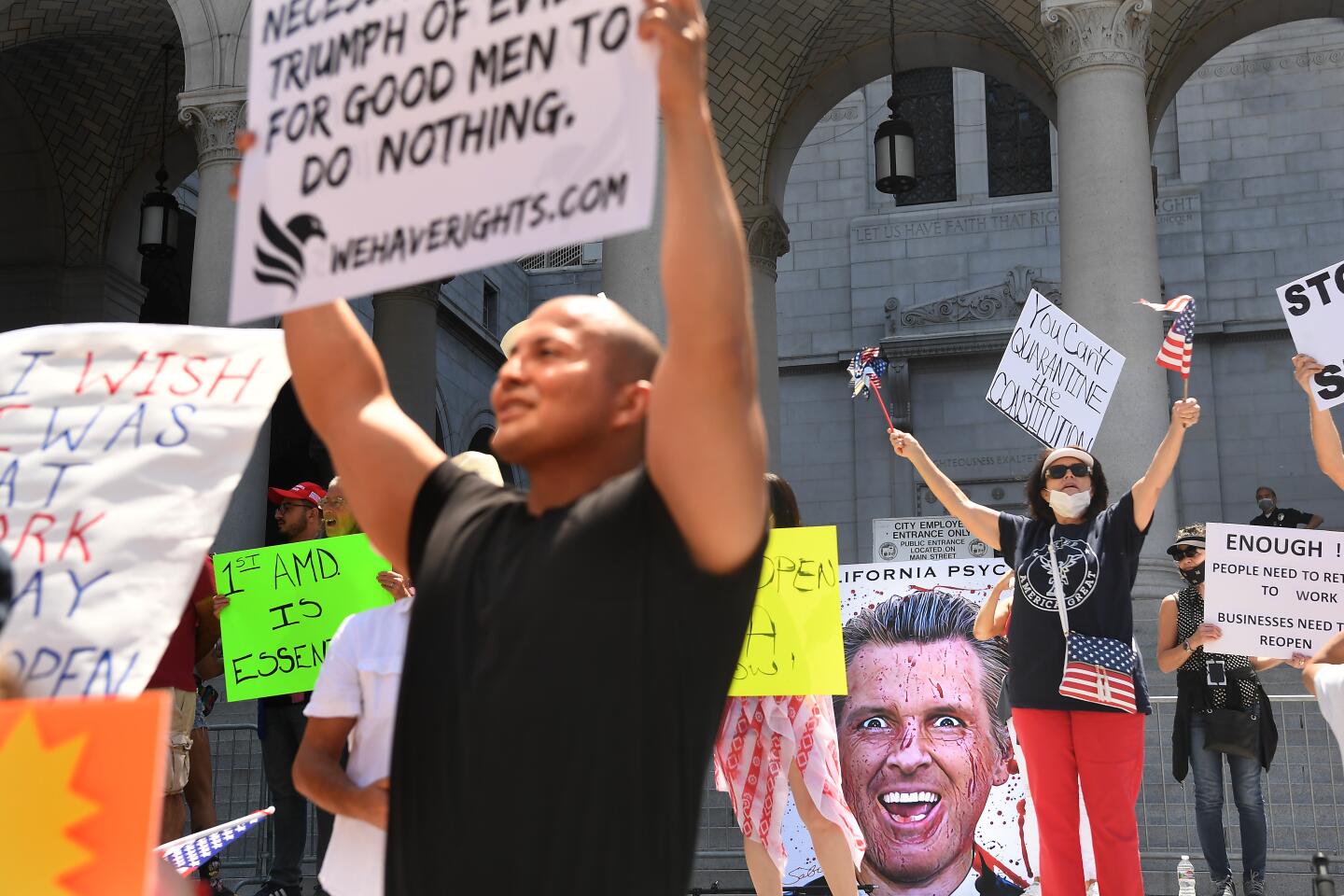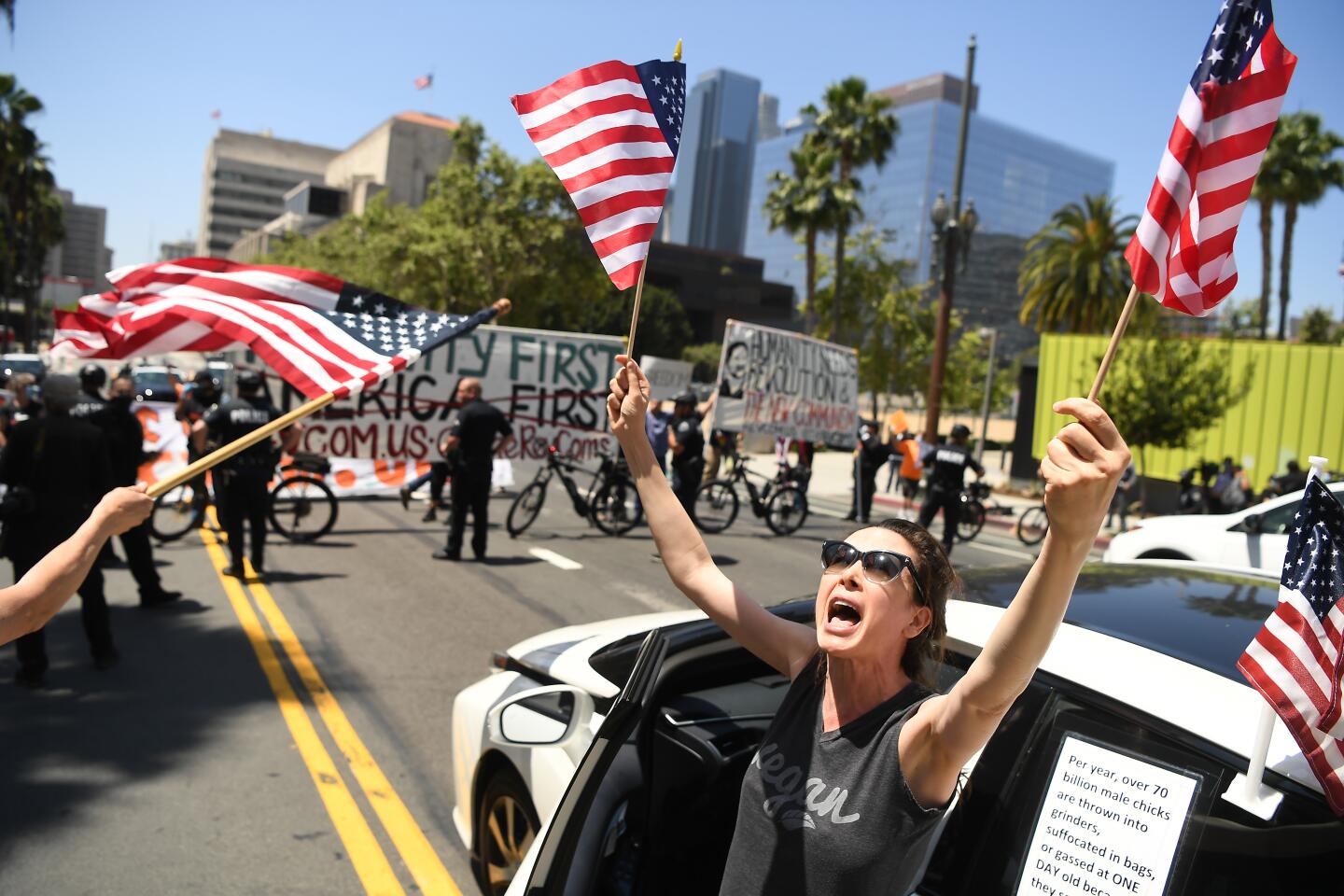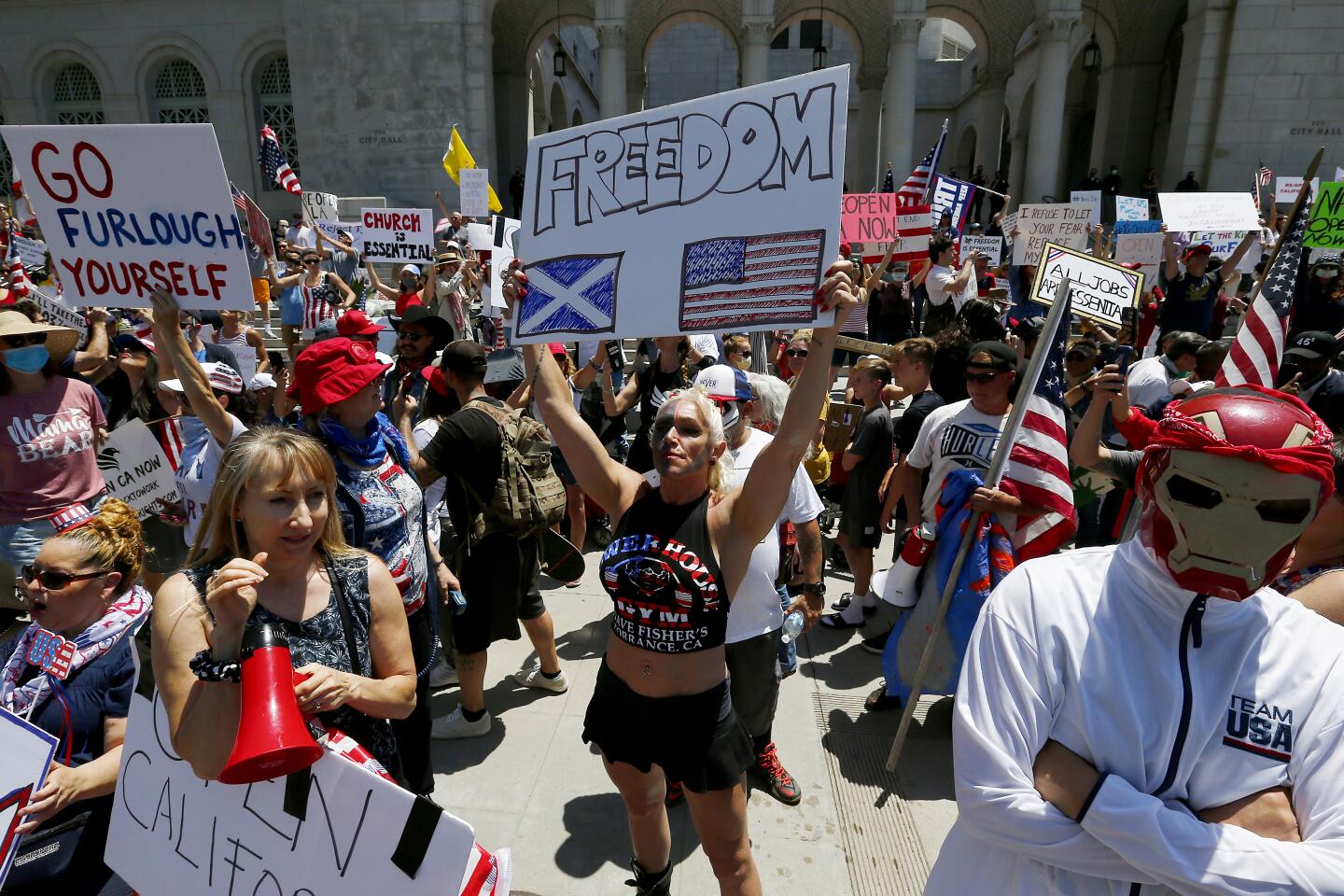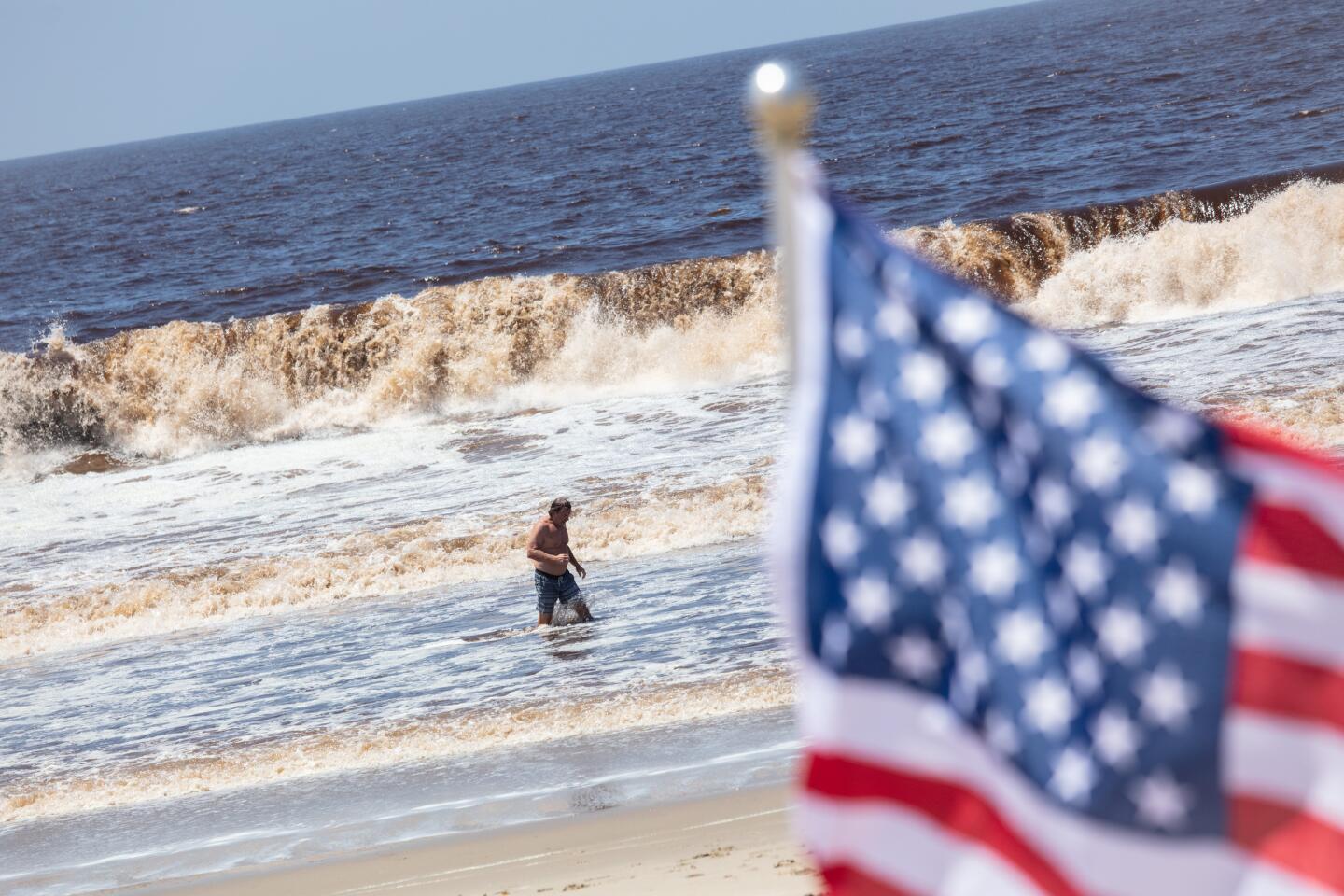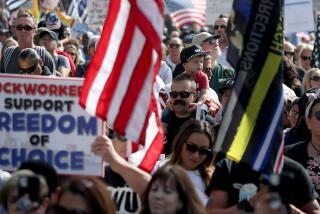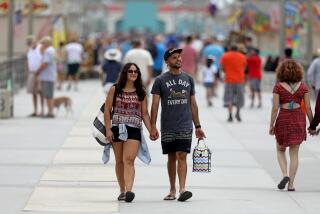At protests, mostly white crowds show how pandemic has widened racial and political divisions
- Share via
The crowds protesting California’s stay-at-home orders aimed at stopping the spread of the novel coronavirus have a litany of grievances: Open the beaches. Free the churches. End the tyranny of a governor who has gone too far.
They hop barricades to surf. They cite the Constitution. They wave American flags. They sport Trump 2020 gear. They rail against vaccines. In other states, including Michigan, protesters have shown up at government buildings carrying rifles.
Despite their varied causes, the protesters have been almost entirely white — even in California, a state that mostly is not.
The raucous protests in wealthy, coastal Orange and San Diego counties and at the state Capitol in recent days have, for many, highlighted racial and class disparities amid a pandemic that has killed more than 2,500 Californians — a disproportionate number of whom are black, Latino and poor.
In Los Angeles County, where nearly half of the state’s more than 61,000 confirmed coronavirus cases are located, public health officials say residents of low-income communities are three times more likely to die of COVID-19 than those in wealthier neighborhoods. A Times data analysis found blacks and Latinos under 50 are dying of coronavirus in significantly greater numbers than other groups, including whites. Experts believe one reason is that many work in “essential” service jobs that require them to leave home, putting them at a higher risk of infection.
The overwhelmingly white makeup of the protests is not lost on people of color, some of whom see it as an overt display of privilege. This has been especially striking in California, where Latinos make up 40% of the population, outnumbering whites.
“When Latinos are out protesting immigration or other problems, the first things you hear are white people saying, ‘Get a job!’ or ‘Follow the rules!’” said Alexis Rodriguez, 22, of East Los Angeles. “But when it’s white people in Huntington Beach, it’s all about ‘fighting for your rights.’”
Rodriguez, a senior at Cal State L.A., and Ashley Arreola, a 25-year-old senior at UC Irvine, were volunteering this week at Eastman Avenue Elementary School in East L.A., handing out laptops to young students who needed them for distance learning. Arreola noted that most of the families , all Latino, wore masks and gloves — unlike the white demonstrators.
The protesters have had a strong ally in the White House. President Trump — who has repeatedly called the novel coronavirus the “Chinese virus,” even after reports of racist attacks on Asian Americans — has encouraged people to demonstrate, tweeting for protesters to “liberate” states with stay-at-home orders.
After White House economic advisor Stephen Moore compared people protesting government lockdowns to a “modern-day Rosa Parks,” Trump said he “could see where he’s coming from.”
In Huntington Beach last week, hundreds of demonstrators gathered to demand stay-at-home orders be lifted and to decry Gov. Gavin Newsom’s temporary closure of Orange County beaches, some of which were allowed to reopen this week.
Huntington Beach Councilman Mike Posey said he had “a hard time believing there’s a racial element to protests.”
“Beaches are open to everyone and the beaches are free... All I saw in the news is people asking the governor for the beach back and for science and data and not to single out Orange County.”
Polls show conservatives are less supportive of stay-at-home orders. Those polls also show the protesters are outliers — with the overwhelming majority of Californians strongly supporting the rules.
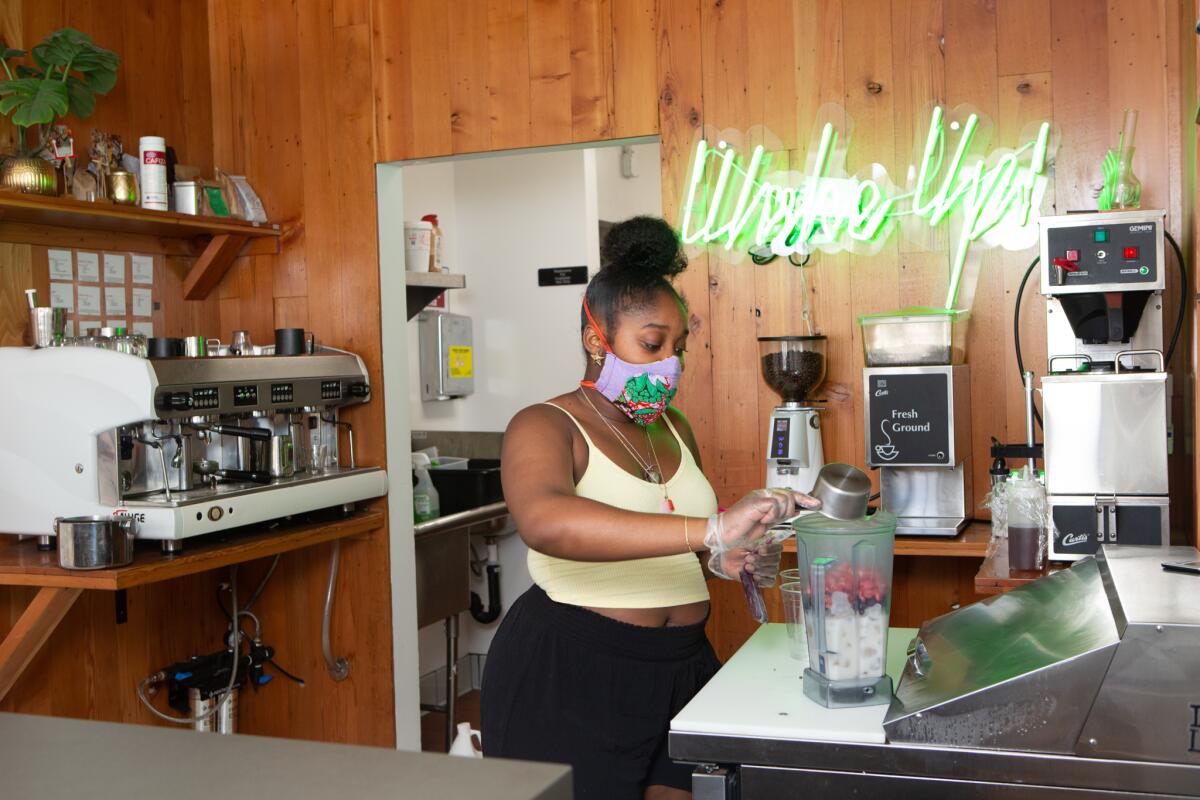
Audrey Webb, a 22-year-old barista at Harun Coffee in Leimert Park, who is black, said she worried that the protesters, crowded together and unmasked, could spread the virus to food service workers, delivery drivers, medical workers, police officers and others on the front lines of the pandemic.
Webb, who wore a mask while she worked, said she worries about her mother, a breast cancer survivor, and her father, a Los Angeles Police Department officer.
“Pandemics don’t pick and choose,” Webb said. “They get everyone. It doesn’t matter if you are in the stock market or if you work stocking a grocery store. The same rules apply to everyone, but people don’t want to act like that. They want to act like, just because they have money, they can say and do as they want.”
Sonia Lewis, a black woman who participated in protests against the fatal shooting of Stephon Clark, an unarmed black man, by Sacramento police in 2018, said there is “most definitely a race issue” in who is protesting the stay-at-home orders.
Lewis, an activist with The Liberation Collective for Black Sacramento, said black business owners are fearful of defying closure orders, even though they face the same economic devastation as their white counterparts.
“I realize that doing business and just existing in my black skin will not give me the ability to defy the law,” said Lewis, who is a doula and runs an educational consulting company.
“I can’t worry about a beach,” she added. “I am worried about my rent and my mortgage and getting my kids fed.”
White men with guns have become a common sight at the protests, including at the state capitols in Wisconsin and Arizona. Protesters carrying assault rifles and wearing tactical gear, some of whom were members of militias, converged on the Michigan statehouse last week. Afterward, Trump tweeted that Democratic Gov. Gretchen Whitmer should “make a deal” with protesters and that they are “very good people, but they are angry.”
Whitmer said this week that some of the protesters carried nooses and Confederate flags and displayed swastikas.
“I don’t think it’s a coincidence that it’s mostly white people out there,” Cassie Miller, a senior research analyst at the Southern Poverty Law Center, said about the demonstrations.
Nationwide, protests have been attended and lauded by white supremacists, members of far-right groups like the Proud Boys, militia members and conspiracy theorists trying to exploit the chaos created by the pandemic, Miller said. In “the most extreme parts of the far right,” people are celebrating the virus because they know that it disproportionately affects minorities, she said.
For Cornell William Brooks, a professor at Harvard University’s Kennedy School of Government and former national president of the NAACP, the protests have recalled an adage: When white America gets a cold, black America gets pneumonia.
Brooks said that when his mother was a teenage student at South Carolina State College in the early 1960s, she dressed up in her Sunday best, wearing a new coat, to protest segregation. She was met by police officers who used fire hoses to push students against the wall.
“That generation was angry about the un-American way they were being treated, but they demonstrated their love for America,” Brooks said. Today’s protesters, he said, are “wrapping themselves in the flag and demonstrating a certain contempt for the country and their fellow citizens. In their civic vocabulary, the pronoun is ‘I’ — ‘I want to be free to do what I want,’ as opposed to a generation that said, ‘We want to be free.’”
A protest outside the statehouse in Sacramento last week included some people who had previously gathered there to decry the Black Lives Matter movement and rally support for law enforcement under the credo “Blue Lives Matter.”
But last week, as California Highway Patrol officers with face shields and full tactical gear began pushing protesters off the Capitol grounds, unmasked protesters, inches from their faces, screamed that they were traitors, urging them to uphold a Constitution they believe is under threat.

“Is this what you signed up for as police?!” one woman screamed.
As the officers advanced, Auburn resident Amber Beasley, who is white, sat down in their path with her 4-month old daughter and her mother, Julia Ebel. Beasley breastfed the infant, defying commands to move. Police formed a circle around her but kept moving, leaving the small group and their stroller alone until Beasley finished. Then an officer held out a hand to help Ebel up.
Asked why she had taken a seat, Beasley replied: “For freedom.”
Leigh Dundas, a human rights attorney from Orange County, stood in a speedboat parked at the Capitol’s curb, exhorting protesters to stand up for their constitutional rights. Last year, she participated in anti-vaccination protests at the statehouse. She said vaccine requirements and the coronavirus shutdowns are government overreach.
Dundas, who is white, said she understands that the virus hits some populations harder than others but believes the overall threat is less than what officials have stated.
“The beauty of America is that if you are in a demographic that subjects you to a higher risk, you have the ability to self-regulate and say, ‘I am at higher risk and I am not going out into the world,’” she said.
Dundas said that while the majority of protesters gathered last week were white, there was both racial and economic diversity. Citing the arrests by California Highway Patrol officers of more than 30 protesters, she said the color of their skin “was not a panacea.”
On Thursday, a group of men wearing Proud Boys T-shirts and carrying a flag with the group’s name were among hundreds of protesters who once again gathered at the state Capitol. Demonstrators said they were angry about last week’s arrests. Some carried signs directed at law enforcement that read: “We forgive you. Join the people.”
At 2 Fast 4 U Wireless, a small cellphone store in East Los Angeles, signs this week instructed customers to stay six feet apart and wear masks. Employee Sandra Castillo, a 25-year-old Latina, said business had plummeted by at least half since the stay-at-home orders went into effect seven weeks ago.
“I think we’re getting close to needing to open up,” she said. “The businesses need it.”
But as for the protesters? “I think they should wear masks and do everything to be safe,” she said.
At a Huntington Beach protest last week, Victor Valladares, 34, a community activist from the city’s predominantly Latino Oak View neighborhood, wore a long-sleeved shirt, dark sunglasses and covered his nose and mouth with an American flag bandanna to fit in. He had come to livestream the protest for the grass-roots group Oak View ComUNIDAD and was not surprised to see few Latinos.
“We’d automatically be labeled as instigators, agitators or trying to start a riot instead of trying to exercise our free speech. They wouldn’t even call us patriots,” Valladares said. “Because they’re white people, they’re patriotic.”
More to Read
Sign up for Essential California
The most important California stories and recommendations in your inbox every morning.
You may occasionally receive promotional content from the Los Angeles Times.
